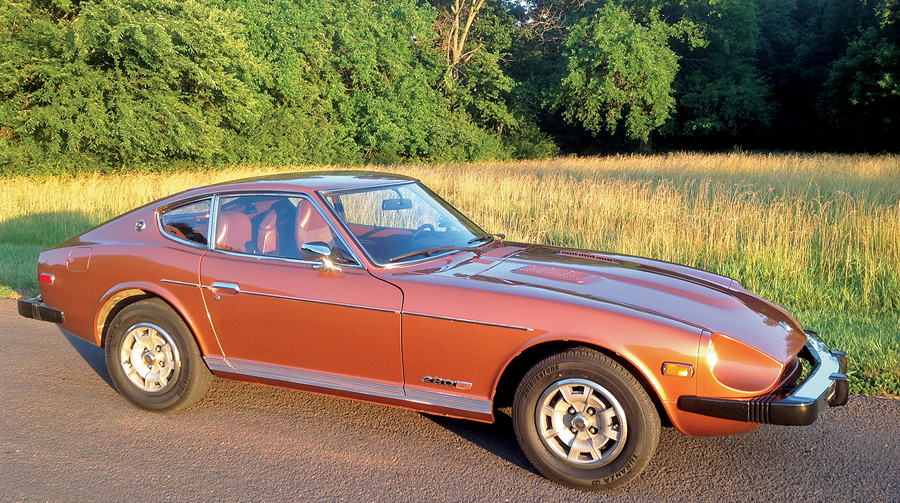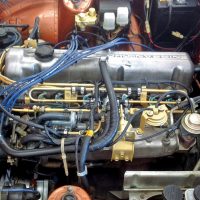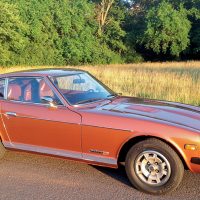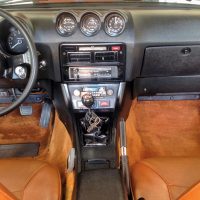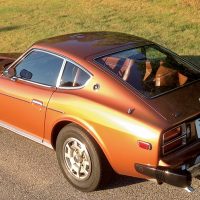- Original paint
- Original drivetrain
- 5-speed manual transmission
- 89,000 actual miles
- Original interior with pristine dash
- Rust-free
- Factory a/c converted to R134A
- New tires and recent alignment
- Dealer optional rocker-panel trim
- Chrome sport mirrors
- Two original keys
- Original owner’s manual
- New fuel, vacuum, brake and coolant hoses
- New fuel filter, lines, pump, injectors and fuel injector connectors
- New spark plugs, wires, distributor cap and rotor
- New battery
- Brakes recently serviced and hydraulic systems flushed
- Maintained with OEM Nissan parts used wherever possible
- Fuel tank removed and cleaned
- Matching VINs on firewall, dashboard, door jamb tag, engine compartment tag
SCM Analysis
Detailing
| Vehicle: | 1977 Datsun 280Z |
| Years Produced: | 1975–78 |
| Number Produced: | 203,275 |
| Original List Price: | $6,359 |
| SCM Valuation: | $11,900 |
| Tune Up Cost: | $65 |
| Distributor Caps: | $20 |
| Chassis Number Location: | Driver’s side of firewall |
| Engine Number Location: | Right side inner fender on ID plate and on the side of the block |
| Club Info: | Z Car Club Association |
| Website: | http://www.zcca.org |
| Alternatives: | 1967–72 Mazda Cosmo, 1965–72 Porsche 911, 1970–77 Toyota Celica |
| Investment Grade: | C |
This car, Lot F52, sold for $44,000, including buyer’s premium, at Mecum’s Kansas City Auction in Kansas City, MO, on December 2, 2016.
Over the past few years, Z cars have shot up in value at auctions around the world. We saw a 1970 240Z sell for $40,700, a 1973 240Z sell for $32,450 and a 1976 280Z 2+2 sell for $50,050. This isn’t exclusive to rare models or one-off cars. These are the mass-produced Zs.
We can’t ignore them anymore.
With Z cars selling at these prices, the owners of these cars have divided into three camps:
The first group is in disbelief that someone would pay so much for a Z. These guys would never pay over four digits for a car.
Another group believes the market is finally adjusting for these classic J-tin cars, and the growing legion of Z fans are driving the recent value increase.
Finally, we have starry-eyed owners of mediocre cars listing them at unrealistically high auction prices. No, your automatic 280Z with a cracked dash, rusted floors and mishmash engine isn’t in the same category as the cars selling for $30k and up.
From the 240Z to the 280Z
The 260Z followed the 240Z in 1974. The 280Z was introduced in 1975.
The 280Z was the second update of the original 240Z. The most notable changes included a 2.8-liter electronic fuel-injection engine, updated interior, bigger gas tank, bigger bumpers and different taillights.
Each year, from 1970 to 1978, Datsun Z cars had slight differences — and slightly different parts. The 280Z’s 2.8-liter performance increase compared with the 240Z’s 2.4-liter engine was negligible, as federally mandated safety equipment and emission requirements sucked away power.
Of the 420,000 Z cars imported to the United States, 148,115 of them were 240Zs, while 203,275 were 280Z cars — not counting the 2+2 version.
The updated interior 280Z is a very nice upgrade over the 240Z, along with the L28 motor. The fuel-injection system is a Bosch L-Jetronic system that is also seen on Alfa Romeos, BMWs, Fiats and Lancias.
This is a very outdated fuel injection system by today’s standards, but it runs great — as long as every component is operating correctly.
The biggest problem with the 280Z is the federally mandated bumpers, which add 75 pounds on to the car and another foot onto the length. These can be swapped out with 240Z bumpers with custom brackets.
A breeding ground for rust
I have seen the term “rust-free” thrown around on many Z cars. The sad truth is that no original Z car is free of rust. A car might appear on the surface as perfect, but look underneath, and there will be rust.
The floor pans on our subject car look great, and so does the spare-tire well. These are common rust locations. I did not examine the car in person. A careful buyer would also look under the battery tray, in the external air inlet for the a/c, inside the fenders and at the lower rockers (especially towards the back of the car).
Why so much?
This particular 280Z is a true example of a near-perfect Datsun Z car.
A few minor fixes would get it to perfection. For example, the lower trim on the sides of the car are bolt-on dealer options. I would stay clear of cars with some of the dealer-option add-ons, as they are not official Datsun parts but third-party parts.
One real gremlin that plagues Z cars is the sunroof, which was never installed at the factory.
The color on most 280Z cars, like this one, is metallic brown, which really dates the cars to the 1970s. The earlier 240Z colors have aged more gracefully. This car has all of the desirable options, including a/c and the harder-to-find 5-speed transmission.
This price for our subject car really shows how hard it is to find a great 280Z. This price is too much for 90% of the surviving Datsun Z cars.
This 280Z has the original paint, the original engine, the original factory-option 5-speed transmission, the original keys and the original dash without any cracks. The previous owner even went through the trouble of tuning the car and cleaning the gas tank.
280Z cars like this only come around every so often, and the bidders knew it.
Expect to see more of these Z cars at auction.
The real value driver is originality, and original cars will usually bring more than restored cars.
Our subject car’s real advantage is that so many 280Zs rusted out over the years, and it’s hard to find great drivers. Every time I drive my 280Z, guys in their 40s and 50s tell me about their old Z car — and how much they miss it.
I expect these people will want to relive those days as more quality Z cars come to auction. The Datsun 280Z is now a five-digit car. ♦
(Introductory description courtesy of Mecum Auctions.)
